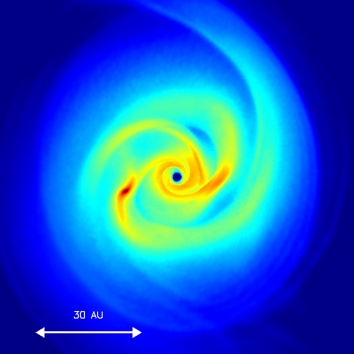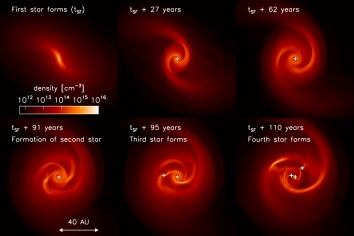First Stars in the Universe Weren't Lonely
3 February 2011
The first stars to form in the universe were not as lonely as previously thought. These are the findings of an international collaboration between researchers at the Center of Astronomy at Heidelberg University, the Max Planck Institute for Astrophysics in Garching, and at The University of Texas at Austin. These results are being published today in Science magazine.
The astrophysicists used state-of-the-art computer simulations to model the birth of the first stars to form after the Big Bang. The group, led by Dr. Paul Clark in Heidelberg and including Dr. Volker Bromm of The University of Texas at Austin, demonstrated that the disk that surrounds primordial stars during their infancy, can break up to form companion stars. These findings challenge the previously-held wisdom that primordial stars formed in complete isolation, rather than in groups typical for stars in our Milky Way Galaxy.
"This simulation pushes our decade-long quest to understand the formation of the first stars one crucial step ahead," Bromm said. "Utilizing cutting-edge supercomputer technology, such as the RANGER system at the Texas Advanced Computing Center (TACC), we now know that the first stars typically did not form alone."
From studying the cosmic microwave background, astronomers know that the universe started out very simple. It was almost completely smooth and uniform, with only tiny fluctuations in density and temperature. Today, however, the universe is highly structured and complicated. Cosmic evolution is thus a progression from simplicity to complexity, with the formation of the first stars marking a primary milestone in this transition.
A few million years after the Big Bang, the expansion of the universe shifted the cosmic radiation field far into infrared wavebands, and so to a human observer, the universe at that time would have been completely dark. The first stars lit up this darkness by shining at visible and ultraviolet wavelengths, bringing an end to the so-called "cosmic dark ages.”
Primordial star formation was a very different process from the type of star formation that occurs today. However one central theme is common to both: the fierce competition between gravitational attraction pulling the star-forming gas together, and thermal energy trying to push it apart.
As gravity squeezes, the gas heats up, so for gravity to win, the gas needs to rid itself of the extra heat produced during the collapse. This was more difficult for gas in the early universe than in galaxies like our Milky Way today, because when the universe was first formed, its gas did not contain elements such as carbon or oxygen, which cool the gas and make it easier to collapse.
Because gas in the early universe did not contain these elements, it was thought that
primordial stars were solitary massive objects. The calculations by Clark and his colleagues demonstrate that this simple picture needs considerable revision due to the physics of the disks that build-up around primordial stars as they form.
Just like the disk around the young Sun that fragmented to build up the planets in our solar system, accretion disks that formed around the first stars were also found to be highly susceptible to fragmentation. Therefore, instead of forming in isolation, the first stars almost always occur as members of multiple stellar systems, with separations as small as the distance between Earth an the Sun.
Bromm explains: "At the end of the primordial star formation process, a massive double-star system likely emerges, driving cosmic history through the production of high-energy photons and the first heavy chemical elements. The binary nature of the first stars opens up exciting possibilities for detecting them, such as in hyper-energetic gamma-ray bursts, or through their strong X-ray radiation."
Future space missions, such as EXIST and JANUS, are being planned specifically to detect gamma ray bursts from the very early universe.
There is also a possibility that some of the first stars may have been ejected from their birth group before they had grown into massive stars, due to encounters with their neighbors. This could lead to primordial stars with a broad range of masses: short-lived, high mass stars which produce high-energy photons — capable of ionizing the primordial hydrogen gas, and enriching the cosmic gas with the first heavy chemical elements — and long-lived, low-mass stars which could survive for billions of years.
The behemoths of the early universe, the massive stars that drive cosmic evolution, were thus accompanied by a retinue of smaller stars, more similar to the Sun. Intriguingly, some low-mass primordial stars might even have survived to the present day, allowing us to probe the earliest stages of star and galaxy formation directly in our cosmic backyard.
With today's announcement, Bromm says, "The pursuit to elucidate the end of the cosmic dark ages is heating up, getting us closer to the final goal of solving the mystery of first light in the universe. But many challenges still lie ahead, to be tackled by the ever-more powerful supercomputers at TACC and elsewhere, and finally by NASA's new James Webb Space Telescope."
Dr. Paul Clark, Dr. Simon Glover, and Dr. Rowan Smith are members of the star-formation group lead by Prof. Dr. Ralf Klessen at the Institute for Theoretical Astrophysics at the Center of Astronomy of Heidelberg University. Dr. Thomas Greif is postdoctoral fellow at the Max Planck Institute for Astrophysics in Garching.
This work was funded by the Baden-Württemberg Stiftung as part of the program
International Collaboration II (grant P-LS-SPII/18), by a FRONTIER innovation grant of the University of Heidelberg funded by the German Excellence Initiative, the US National Science Foundation (grants AST-0708795 and AST-1009928), and NASA (grant NNX08AL43G). The computations we performed at the Texas Advanced Computing Center and on KOLOB, a GPU-accelerated supercomputer jointly operated by the Center of Astronomy and the Institute for Technical Informatics in Heidelberg.
— END —
Media Contacts
Rebecca Johnson (University of Texas at Austin): 512-475-6763
Mirjam Mohr (University of Heidelberg): +49 6221 5419022
Science Contact
Dr. Volker Bromm (University of Texas at Austin): 512-471-3432








